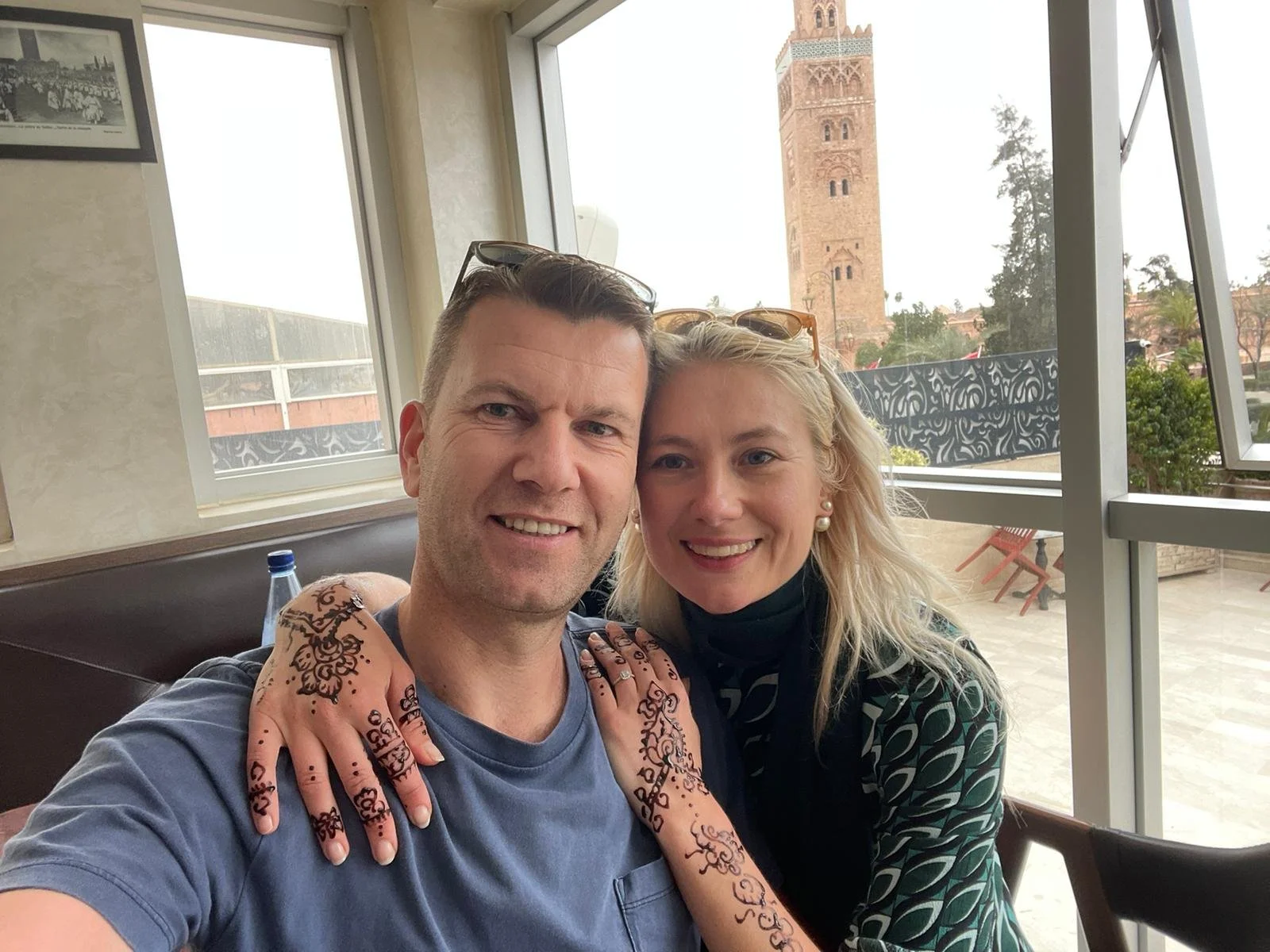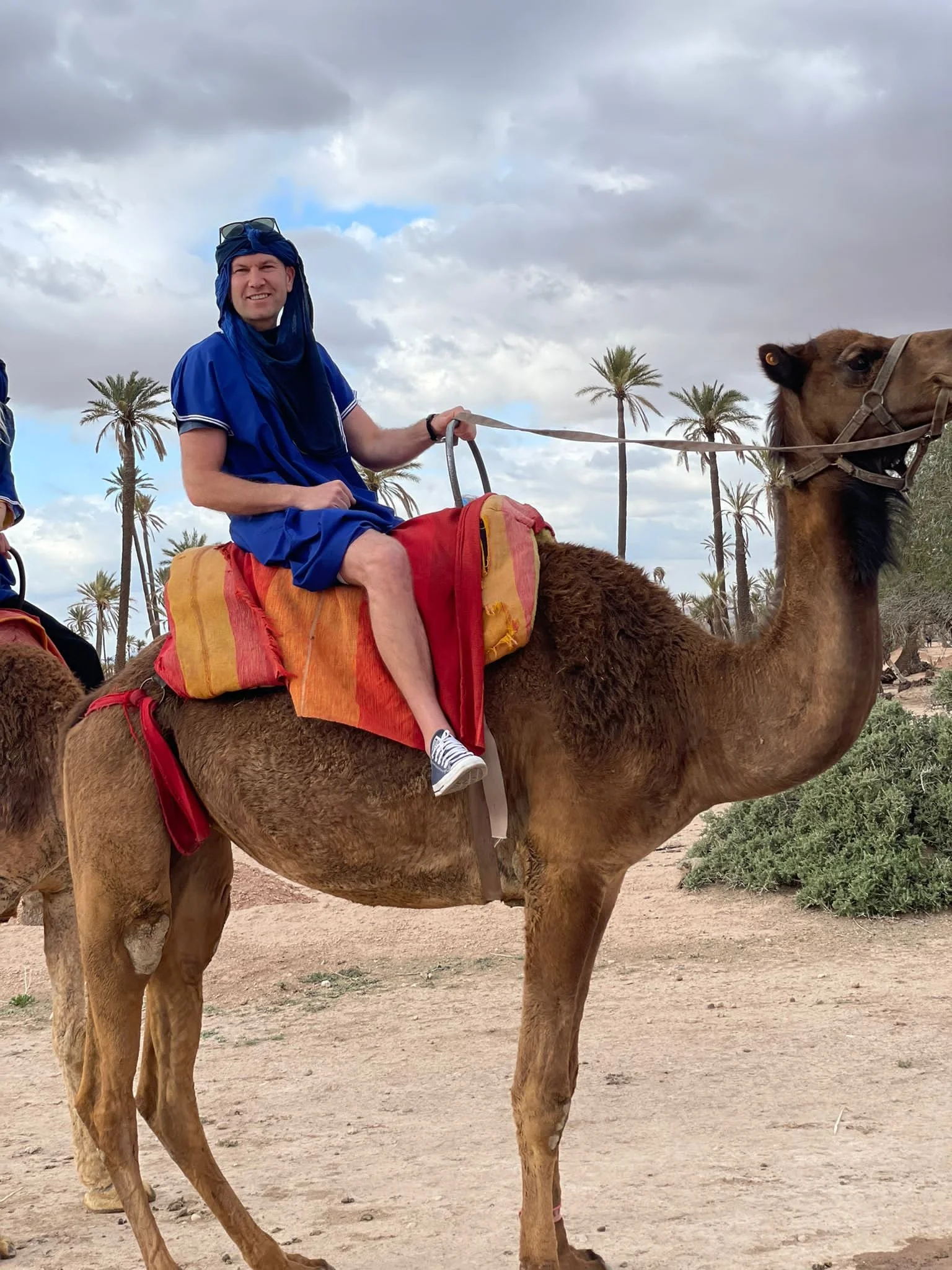🇲🇦 Marrakech — Adventure, Colour, and Culture
✈️ Arrival & First Impressions
Before our trip, my husband’s friend — originally from Marrakech — told us not to stay at a riad in the Medina: “Beautiful pictures, but dark streets at night and dangerous.” I thought, what a load of nonsense! But still listened, and cancelled our Riad Jemaa el Fna & Spa booking. Instead, we booked Dar Rhizane, Palais Table d’hotel & Spa.
Travel day was chaotic — the airport roads were blocked, we ran to catch our flight, and finally sat down took our breath as we made it.. On arrival, the neighborhood looked dodgy and dark, and the taxi driver first dropped us in the middle of a random square- wrong place . I was scared; my husband was baffled. Eventually, we reached our hotel.
The hotel was amazing — luxurious and beautiful.
Hungry from travel, we headed out. Walking in the dark was not so pleasant, but we made our way to Gueliz, the modern central district, just as the friend recommended. At first, I was silently disappointed — no riad charm, no Medina streets — but the next day I saw how good the idea was.
We found La Palette (https://www.lapalette-restaurant.com) — entrance looked trashy like an old warehouse a palette top of the door and security standing front of it, but inside it was impressive. We met the owner and ordered half the menu: tagine, duck breast, all the French-Moroccan specialties. The food was comforting and delicious, and a cat called Palette wandered around.
🌞 First Morning & Islamic Art Inspiration
The morning revealed the hotel in full light. I loved the colors and tiles — truly breathtaking. The story of Marrakech tiles, zellige, is rooted in 10th-century Islamic tradition. Intricate geometric patterns were created because figurative art was forbidden.
The prohibition of living figures in Islamic art stems from the belief that only God can create life, and creating images of living beings is seen as imitating God’s creation, which could lead to idolatry.
Originally a sign of wealth for palaces and mosques, the process continues today, blending mathematical precision with artistic expression. I was so inspired, thinking some day I’d have zellige in my home. Moroccan breakfast was rich, full of small plates, striking colors, and beautiful presentation.
🌿 Jardin Majorelle & Color Adventure
We walked to Jardin Majorelle, improvising and getting lost, then finding our way again. The weather at the end of March was sunny and warm. The garden did not disappoint — Majorelle blue everywhere, bold and beautiful.
Jardin Majorelle was created by French painter Jacques Majorelle in 1923, transforming the land into a botanical garden. Facing financial struggles, Majorelle opened it to the public in 1947. After falling into disrepair, Yves Saint Laurent and Pierre Bergé restored it in 1980.
On the way to the old town, a man claimed to be a gardener inside the Jardin and offered to guide us. He said he knew Berbers selling beautiful grafted souvenirs. We followed him, had mint tea, and looked around. Later, we realized these “helpers” often expect money afterward for being friends — something to always be aware of.
🐐 Medina, Tanneries & Silk Scarf Adventure
In the old town streets, we encountered more helpers or so called friends trying to guide us to shops. One took us to the tanneries, allegedly centuries-old with families working there for generations. The smell was strong, but seeing the age-old techniques of soaking and dyeing hides was fascinating.
We got stuck in a tannery shop and had no way out without buying something. Prices were high, but we huggled and bought a cactus silk scarf — it’s now one of my most beautiful scarves. comes out It’s rare and special, both because of the unique cactus fibers and the sustainable, handmade process. Owning a cactus silk scarf means you have something eco-friendly, one-of-a-kind, and luxurious, not something mass-produced. It’s definitely a great souvenir and keepsake from Marrakech.
Later, tired of the “Friends”, we overheard some older ladies asking for directions to Nomad rooftop restaurant. We secretly followed them — it felt like a little escape from the market chaos. The rooftop was luxurious, the lunch amazing, and a perfect contrast to the wild streets below (https://nomadmarrakech.com).
🐪 Pool, Camels, and Henna
Next day we enjoyed the hotel pool, which was fantastic. Later, we booked a camel ride — magical, and very scenic.
In the old town, we saw cobras, monkeys, and people taking photos with animals — a little unsettling. Henna was everywhere, and I had read to be cautious, but the woman I chose did a beautiful, safe henna design right on the spot.
By the end of the trip, we were exhilarated and inspired. Marrakech is a whirlwind of color, culture, adventure, and learning.
🎨 Artist’s Eye – Marrakech Palette
Tiles & Zellige patterns: deep blues, emerald greens, golden ochres
Jardin Majorelle: bold Majorelle blue, lush greens, sunny yellows
Markets & Spices: vibrant reds, saffron, paprika, orange
Architecture: earthy ochres, burnt sienna, terra-cotta rooftops
Street life: rich shadows, sunlit streets, neon textiles
Every corner felt like a living canvas, full of texture, color, and energy.
🗺️ Places We Visited
Dar Rhizane, Palais Table d’hotel & Spa – luxurious home-away-from-home
Gueliz district – modern Marrakech heart
La Palette – cozy French-Moroccan cuisine with a cat mascot
Jardin Majorelle & Yves Saint Laurent Museum – bold blue oasis
Old Medina & Tanneries – centuries-old leather craftsmanship
Nomad Rooftop Restaurant – rooftop escape from market chaos
Kutubiyya Mosque – iconic architecture
Camel ride excursions – desert adventure
Henna street experience – living Moroccan artistry
📝 Fun Facts & Cultural Insights – Marrakech
Zellige Tiles: Each geometric tile is handmade, a tradition over 1,000 years old. No living figures are used — only intricate patterns — because in Islamic art, depicting life is believed to imitate God’s creation. These tiles were originally reserved for palaces and mosques.
Jardin Majorelle Blue: The bold blue you see in the garden was created by Jacques Majorelle and restored by Yves Saint Laurent. It’s called Majorelle Blue and has inspired countless artists, designers, and architects worldwide.
Medina Helpers: Street guides and “friendly locals” sometimes offer directions or souvenirs, but often expect payment afterward. Best strategy: enjoy their stories and tips, but stay aware!
Tanneries: Many tanneries have been in the same family for generations. Animal hides are soaked in various natural vats (some using pigeon droppings!) and dyed using age-old methods. The smell can be strong, but it’s an unforgettable experience.
Berber Crafts & Souks: Handmade carpets, leather goods, silver jewelry, and grafted souvenirs are everywhere. Haggling is part of the experience — embrace it as part of the adventure.
Henna: Traditional henna designs are temporary works of art, often applied on hands, feet, or arms. Always ensure the henna is natural and applied in a safe environment.
Camel Rides & Desert Experiences: Iconic Moroccan activity, usually just outside the city. It’s a way to experience the landscapes that inspired centuries of art and storytelling.
Moroccan Cuisine: Tagines, couscous, lamb stew, and pastries are staples. Don’t miss local cafés like La Paletteor Nomad Rooftop for a mix of Moroccan and French influences.
Color Everywhere: From tiles to textiles, spices, markets, gardens, and rooftops, Marrakech is a visual feast. Every street is a study in color, pattern, and contrast — a true playground for an artist’s eye.

























































